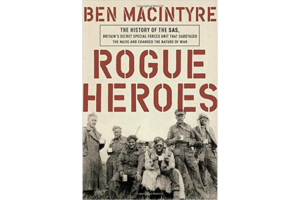'Rogue Heroes' traces the wild WWII theatrics of Britain's Special Air Services
The author of 'Agent Zigzag' and 'A Spy Among Friends' turns to the history of Britain's unconventional, improvisational paratroopers.

Rogue Heroes:
The History of the SAS, Britain's Secret Special Forces Unit That Sabotaged the Nazis and Changed the Nature of War
By Ben Macintyre
Crown
400 pp.
They were reprobates and ruffians; audacious freethinkers and eccentrics. Some were short a full deck, and others were plug-uglies, dark and cruel, who “blurred the distinction between rough justice and cold-blooded killing.” To Britain’s military traditionalists during World War II, the Special Air Service – SAS for short – were “the sweepings of the public schools and the prisons”: impertinent saboteurs, assassins, and damned unsporting.
Damned right, says Ben Macintyre in his new book, Rogue Heroes: The History of the SAS, Britain’s Secret Special Forces Unit that Sabotaged the Nazis and Changed the Nature of War. The author of "A Spy Among Friends" and "Agent Zigzag" sketches a rumbustious, polychromatic group portrait of a young corps of unconventional fighters, more interested in the war than in the army. For what they did – infiltrate themselves behind enemy lines, there to wreak as much havoc on the Axis forces as their imaginations could muster – required self-reliance and instantaneous decision making. (For their own part, the SAS referred to the regular army that snubbed them as “freemasons of mediocrity.”)
One of the remarkable aspects of Macintyre’s authorized-if-not-official history is that he keeps a cool hand on the theatrics (the availability of daring encounters simply begs for pyrotechnics) while maintaining an edge-of-the-seat narrative. The exploits have an authentic feel – he was able to work from primary source material, which certainly helped – and it is no easy thing to capture the spell of dire circumstance and distill it in such a way to be experiential to those who’ve never spent a moment wondering where in the darkness that sniper is. The writing gives us a taste of today’s Deltas and SEALs, where this type of activity is carried out numerous times, every night, somewhere in the world. Clandestine fighting is nothing new, but its modern manifestation was the brainstorm of an irresponsible, gadabout Scottish aristocrat.
David Stirling dreamed up the SAS while recuperating from a parachuting accident. Unschooled but fascinated by parachuting’s military prospects, Stirling simply improvised a test run. Three men threw themselves out of a totally inappropriate aircraft: first a Mr. Lewes, then a Mr. D’Arcy, then Mr. Stirling. “D’Arcy later wrote: ‘I was surprised to see Lieutenant Stirling pass me in the air.’ ” (Among the pleasures of "Rogue Heroes" are the quotes Macintyre pulls from the diaries and letters of the SAS men.)
Stirling, whose chute had fouled, must have been surprised, too, and unhappily. Yet, bed rest following that mishap gave Stirling opportunity to hatch a plan: drop small, highly mobile groups of raiders behind enemy lines to conduct improvisational sabotage and ambushes, sow confusion, sap morale. They would have to be fearless, crazy, or both, but they could be instrumental in disrupting Axis plans. They would also provide what might have been an even greater purpose: “War was not just a matter of bombs and bullets, but of capturing imaginations.” Stirling’s combination of daring and romance made him the perfect Scarlet Pimpernel. He was the personification of T. E. Lawrence’s words: “Nine-tenths of tactics are certain, and taught in books: but the irrational tenth is like the kingfisher flashing across the pool.” That, and Stirling’s successful wooing of Winston Churchill to form his unit.
Macintyre goes through each SAS operation, long on details while improbably light on his feet: “The SAS had fought desert war, guerrilla war, and conventional war [to their dismay], a war in forests, mountains, and fields, on freezing snow, clinging mud, and baking sand.” They were the sharp end of the stick. One day it would be Thermopylae, with a handful of irregulars fighting off an entire Panzer division; the next day, they would be Hannibal in reverse, hightailing it over freezing mountain passes in northern Italy.
There are also the particulars, which Macintyre attends to assiduously, such as the Libyan Taxi Service (the Long Range Desert Group, who ferried the SAS around the German flanks) or the two rowboats that passed in the Mediterranean night, one full of SAS men, the other manned by Patrick Leigh Fermor, “on a mission to link up with the Cretan partisans.” They “‘exchanged shadow greetings’ in the twilight, and paddled on.” These little intimacies lighten tales burdened by scenes of death and carnage.
The men of the SAS, and the men and women they work with and against, take the limelight in what heretofore was a shadow play. If Macintyre cannot look into their minds, with the exception of a few who survive today, he can read their actions, pick up on their frictions, rivalries, and friendships. They become close enough in view for their deaths to sting and their successes to occasion a hoot of gratification. They are filthy, happy, and dangerous, one an ice cream maker, others including a potato farmer from the Channel Islands, a bagpiper, an international rugby star, and more Scottish aristos than there are crags in the Highlands. As well, Macintyre watches as the war grinds on and even those with a predilection for risk wear thin. Internal demons were gaining ground: “Something was crumbling within.” Peace would not come too soon for the SAS.
In the end, Macintyre doesn’t have to sing their praises. He lets others do it. Consider the most starched and prickly of all: General Bernard Montgomery, the crustiest of the old-schoolers, who looked on the SAS with a jaundiced eye, but still ... “The boy Stirling is mad. Quite, quite mad. However, in war there is often a place for mad people.”

